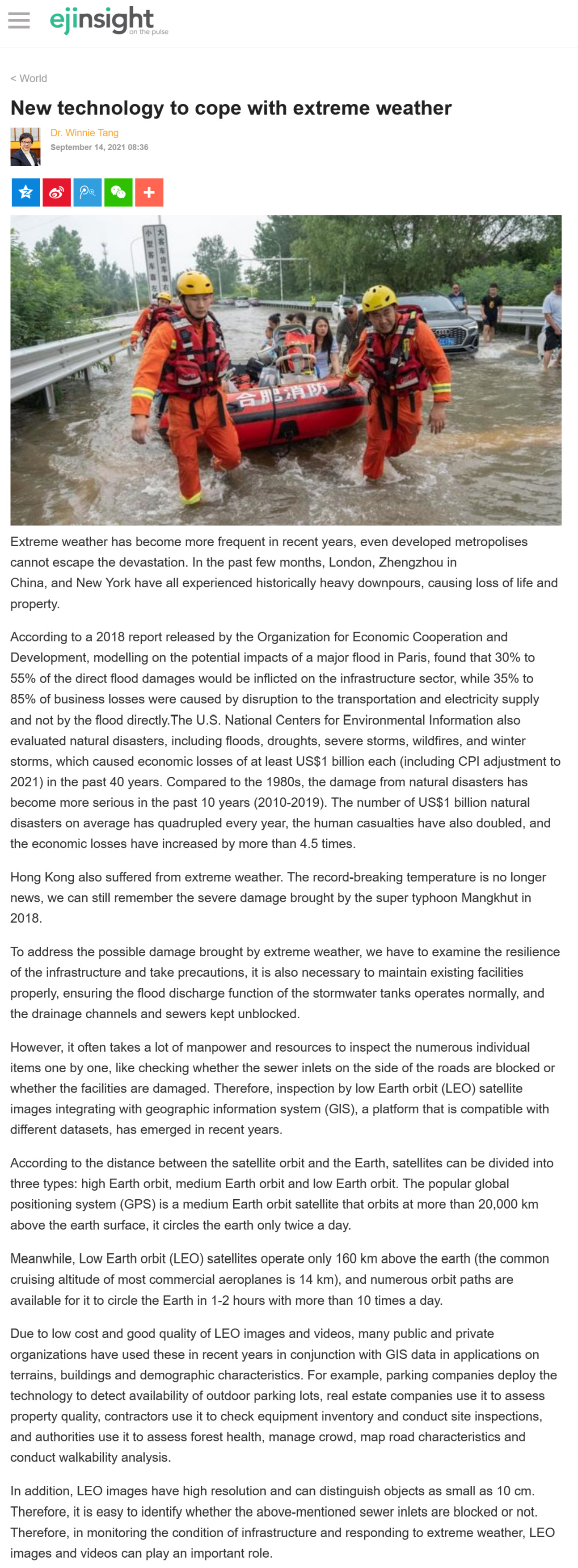網上版請按此

New technology to cope with extreme weather
Extreme weather has become more frequent in recent years, even developed metropolises cannot escape the devastation. In the past few months, London, Zhengzhou in China, and New York have all experienced historically heavy downpours, causing loss of life and property.
According to a 2018 report released by the Organization for Economic Cooperation and Development, modelling on the potential impacts of a major flood in Paris, found that 30% to 55% of the direct flood damages would be inflicted on the infrastructure sector, while 35% to 85% of business losses were caused by disruption to the transportation and electricity supply and not by the flood directly.The U.S. National Centers for Environmental Information also evaluated natural disasters, including floods, droughts, severe storms, wildfires, and winter storms, which caused economic losses of at least US$1 billion each (including CPI adjustment to 2021) in the past 40 years. Compared to the 1980s, the damage from natural disasters has become more serious in the past 10 years (2010-2019). The number of US$1 billion natural disasters on average has quadrupled every year, the human casualties have also doubled, and the economic losses have increased by more than 4.5 times.
Hong Kong also suffered from extreme weather. The record-breaking temperature is no longer news, we can still remember the severe damage brought by the super typhoon Mangkhut in 2018.
To address the possible damage brought by extreme weather, we have to examine the resilience of the infrastructure and take precautions, it is also necessary to maintain existing facilities properly, ensuring the flood discharge function of the stormwater tanks operates normally, and the drainage channels and sewers kept unblocked.
However, it often takes a lot of manpower and resources to inspect the numerous individual items one by one, like checking whether the sewer inlets on the side of the roads are blocked or whether the facilities are damaged. Therefore, inspection by low Earth orbit (LEO) satellite images integrating with geographic information system (GlS), a platform that is compatible with different datasets, has emerged in recent years.
According to the distance between the satellite orbit and the Earth, satellites can be divided into three types: high Earth orbit, medium Earth orbit and low Earth orbit. The popular global positioning system (GPS) is a medium Earth orbit satellite that orbits at more than 20,000 km above the earth surface, it circles the earth only twice a day.
Meanwhile, Low Earth orbit (LEO) satellites operate only 160 km above the earth (the common cruising altitude of most commercial aeroplanes is 14 km), and numerous orbit paths are available for it to circle the Earth in 1-2 hours with more than 10 times a day.
Due to low cost and good quality of LEO images and videos, many public and private organizations have used these in recent years in conjunction with GIS data in applications on terrains, buildings and demographic characteristics. For example, parking companies deploy the technology to detect availability of outdoor parking lots, real estate companies use it to assess property quality, contractors use it to check equipment inventory and conduct site inspections, and authorities use it to assess forest health, manage crowd, map road characteristics and conduct walkability analysis.
In addition, LEO images have high resolution and can distinguish objects as small as 10 cm. Therefore, it is easy to identify whether the above-mentioned sewer inlets are blocked or not. Therefore, in monitoring the condition of infrastructure and responding to extreme weather, LEO images and videos can play an important role.
Dr. Winnie Tang
Adjunct Professor, Department of Computer Science, Faculty of Engineering; Department of Geography, Faculty of Social Sciences; and Faculty of Architecture, The University of Hong Kong